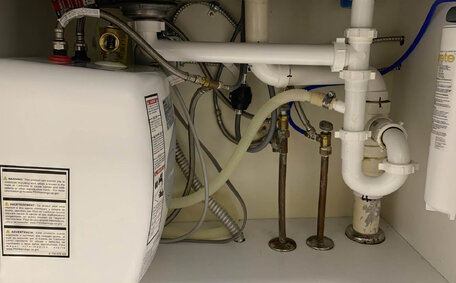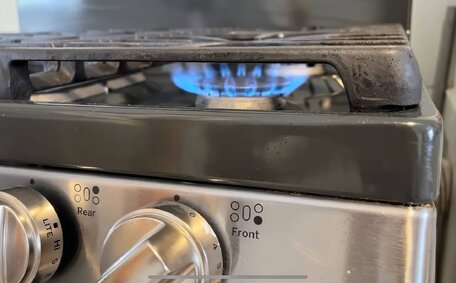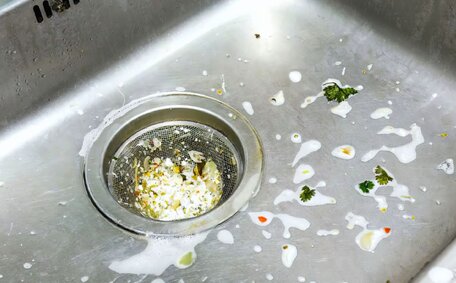Types of Chemical Drain Cleaners and How They Work
There are three main types of chemical drain cleaners:
Acid-Based Drain Cleaners
Acid-based drain cleaners, using sulfuric or hydrochloric acid, effectively disintegrate clogs through intense chemical reactions and, due to their causticity, are generally reserved for licensed professionals.
Acid-based drain cleaners corrode and dissolve all types clogs, including various organic materials like hair, grease, food scraps, and toilet tissue. While very effective at clearing tough blockages, they can damage pipes if used improperly.
Alkaline Drain Cleaners
Alkaline drain cleaners containing sodium hydroxide or potassium hydroxide dissolve clogs by generating heat that helps break up fatty substances. Caustic drain Alkaline cleaners, which are chemical solutions, can damage pipes, react with metals, and are harmful if they come into contact with skin.
Enzyme Drain Cleaners
Enzyme cleaners offer an alternative to caustic drain cleaners, containing bacteria, enzymes, or oxygenated compounds that break down organic matter. They biologically process fats, oils, congealed grease, food residue, strands of hair, and your toilet paper remnants to aid in clearing slow-moving clogs. Enzymes are a safer option for your plumbing system, providing that you follow the instructions correctly.
Pros: Why People Use Chemical Drain Cleaners
Fast and Effective
Acidic drain cleaners rapidly emulsify grease, hair, and soap scum, swiftly restoring your system’s water flow.
Convenience
Penetrate Deep Clogs
Chemical drain products often penetrate deeply into your drains to resolve obstructions further down the sewer line. This allows them to tackle clogs beyond the reach of plungers or hand snakes.
They are inexpensive and easy to find
A variety of drain unblockers are readily available at supermarkets and hardware stores at a low cost, offering an affordable solution for clogged drains.
As these cleaners are commonly stocked on store shelves, they can be easily purchased when needed without the wait required to acquire caustic industrial products. Their availability and low cost make chemical drain cleaners the go-to for many homeowners before calling a plumber.
They can effectively clear organic clogs
Drain cleaners with potent acidic or alkaline ingredients, such as lye, swiftly dissolve clogs made of hair, grease, and other organics.
The heat generated by the exothermic chemical reaction can also help liquefy solidified grease but may damage your pipes in your drain. So for obstructions not effectively addressable by using chemical drain methods caused by accumulation of household gunk, chemical cleaners can clear them quicker than home remedies.
It’s worth noting that large masses of hair or grease may resist penetration by chemical agents.
Cons: Risks and Downsides of Chemical Drain Cleaners
Can Damage Pipes
The corrosive ingredients in chemical drain cleaners can damage pipes, especially older pipes made of cast iron or galvanised steel. The caustic acids and bases erode at the protective inner lining, which chemicals can damage your home’s piping integrity by causing corrosion and leaks.
Toxic Fumes
When deployed, chemical drain cleaners emit hazardous vapours laden with volatile organic compounds (VOCs) and other irritants that could cause respiratory distress. Exposure can harm your health, leading to headaches, nausea, and other issues.
Environmental Impact
Chemical drain cleaners can disrupt ecosystems, causing algal blooms and contaminating waterways.
They are highly corrosive and can damage pipes
Chemical drain cleaners contain substances like sulfuric acid which can cause damage to pipes over time. The acidic or caustic formulas corrode protective inner coatings, allowing rust to eat out your pipes, causing deterioration to occur.
Older pipes made of materials like cast iron, galvanised steel, clay, and even PVC pipes are especially vulnerable. The chemicals wear down these materials, creating weak spots prone to cracks and leaks. They also react with clogs to generate heat, warping or melting pipes.
Continual usage of chemical drain openers can introduce corrosive agents into various types of pipes, resulting in significant deterioration in the long run. Short-term solutions like these can lead to major plumbing issues requiring costly repairs over time. Even small pinhole leaks in pipes buried under floors or behind walls can create messy water damage.
They are extremely hazardous if mishandled
Handling chemical drain cleaners requires caution; sulfuric acid can lead to severe injuries if there’s improper use. Spilling cleaners on the skin or eyes can result in painful chemical burns. The release of toxic fumes from these cleaners upon use can lead to lung irritation or headaches.
If small children or pets ingest chemical drain cleaners, it can be extremely dangerous or even fatal due to the corrosivity destroying soft tissues. Extreme caution is essential to never combine different drain cleaning products, as hazardous reactions can ensue, emitting heat and noxious gases.
Proper hygiene is crucial when using a chemical cleaner to avoid accidents. Gloves, goggles, and ventilation must be used.
Ensure containers are firmly closed and placed in safe storage, out of the reach of curious children and pets. Any spills or injuries do use immediate medical assistance as chemical contamination spreads rapidly on the skin or eyes.
They have negative environmental impacts
Chemical drain cleaners have concerning environmental impacts, especially if poured into your septic system or down drains. Their hazardous ingredients like sulfuric acid, lye, solvents, and VOC vapours can harm the soil and contaminate groundwater. Drain cleaners upset natural ecosystems, harming vegetation and aquatic life when released untreated into waterways.
Many municipalities prohibit or restrict the disposal of chemical drain cleaners for this reason. They can disturb biological processes during wastewater treatment, causing issues at water recycling facilities. The toxins can persist for extended periods, threatening the health of critical resources such as reservoirs and rivers from which drinking water is drawn.
Environmental contamination is difficult and costly to remediate so preventing it is prudent. Specialised handling of chemical drain cleaner waste is required to avoid ecological damage and comply with hazardous materials regulations.
Non-Chemical Alternatives for Drain Cleaning
There are several effective natural drain cleaner methods for clearing clogged drains without the risks of chemical cleaners.
Plunging
For your sink, tubs, and showers, a standard sink plunger can help push the clog through. Cover the drain completely with the plunger and plunge up and down rapidly to apply force to the blockage.
Snaking
A makeshift coat hanger tool or flexible metal snake can retrieve obstacles like clumps of hair, debris, and accumulations, bringing them to the surface. Feed the snake down through standing water for extra pressure. Crank augers are more powerful for tougher obstructions.
Boil a kettle and slowly pour the water down the drain, a safer alternative to potentially damaging chemical cleaners. Let sit for 10-15 minutes before flushing with cold water.
Baking Soda and Vinegar
The chemical reaction can break up organic matter effectively. Flush with boiling water after use for 5-10 minutes.
For persistent or serious blockages, our team advises collaborating with skilled plumbing professionals who can precisely and securely clear drains using techniques like hydro jetting or motor-driven snakes.
Using a Plunger
Using a plunger is one of the easiest and safest first steps for clearing a clogged drain. Here is a simple guide to effectively plunge a drain:
- Fill the sink about halfway with water. Make sure the drain opening is fully submerged.
- Place the plunger firmly over the drain opening, creating a tight seal on all edges.
- Work the plunger up and down rapidly 10-15 times, applying force on the downstroke. This builds up pressure against the clog.
- Angling the force while plunging helps to dislodge the blockage from various angles.
- Remove the plunger and flush the drain with hot water. Repeat steps as needed until the clog clears.
Use a flange plunger, specifically designed for sink drains, for optimal results. Exercise caution rather than using chemical means which could scratch enamel or damage pipes when plunging forcefully.
If plunging fails to open the clog, a mechanical snake or professional drain cleaning methods may be required to remove stubborn obstructions.
Snaking the Drain
Flexible drain snakes can physically remove clogs, including those resulting from tree roots, which may challenge chemical cleaners. A metal snake is more effective for obstructions caused tree roots by hair, grease, debris, small objects, and grit that require mechanical removal rather than dissolving.
To use a drain snake:
- Protect hands with gloves and insert the hooked end of the snake into the drain opening.
- Turn the handle clockwise while applying light downward pressure to feed the snake deeper into the pipes.
- Once resistance is felt, crank the handle back and forth while maintaining pressure to grab the clog.
- Slowly extract the snake, pulling out debris wrapped around the hooked end.
- Flush with hot water, ensuring there no residue remains. To fully clear the obstruction, repeat if needed once you know about the nature of the clog.
For drains deeper than 10 feet, use a powered drill snake with an adaptable length cable to reach clogs further down the line. Always take care not to scratch pipes with the metal spring.
Compared to chemical cleaners, drain snakes provide lasting clog relief by extracting the mass of hair and gunk rather than just dissolving some of the buildup.
Boiling Water
Pouring boiling water down your drain can help melt and dislodge grease clogs. As an affordable and readily available solution, boiling water is a safe first option before resorting to harsh chemicals.
To use this method and prevent future build up:
- Boil a full kettle of water and leave to cool slightly so it stops actively boiling.
- Carefully pour the hot water slowly down the drain.
- Let it sit for 10-15 minutes to allow the heat to liquefy solid grease.
- Flush down with cold water. Repeat if the drain remains partly clogged.
Boiling water is particularly effective for dissolving small grease clogs. It also cannot dissolve other materials like hair or grit, prompting homeowners to reach out for alternative solutions.
Overall, it’s a safe DIY solution to try before you call plumber.
Preventing Clogs in the First Place
The best way to avoid a blocked drain is to stop debris from building up in pipes in the first place. Some simple preventive measures include:
- Use drain screens that are heavier than water in sinks and tubs to trap hair and food scraps before they wash down.
- Dispose of fats, oils and food waste in the trash rather than rinsing down drains to avoid grease accumulation.
- Flush toilets with care, in the form we recommend, to prevent overflowing or accidentally dropped items from causing blockages.
- Have drains professionally cleaned every year or two to clear any minor buildup before major blockages occur.
Preventive maintenance protects plumbing and the environment.
Properly Dispose of Food Waste
One of the main causes of clogged drains is food waste washed down the sink. Fats, oils, and food scraps accumulate in pipes over time, leading to blockages. To avoid this, proper disposal of food waste in the trash rather than the sink is crucial.
Scrape and wipe leftover fats, grease, and solids off plates into the bin before rinsing.
Compost plant-based waste like fruit and vegetable peels if possible.
Adopting a few small kitchen habits to keep food waste out of drains demonstrates the advantages of such practice over the risks associated with chemical cleaners. This preventive step protects pipes from clogs that would otherwise require risky chemical drain cleaners to clear. Proper food waste disposal maintains plumbing health.
Install Drain Screens
Installing drain screens or catchers is an effective way to prevent hair, food scraps, and other debris from washing down sinks and tubs to cause clogs.
Stainless steel screens fit into drain pipes to block solids while allowing water to pass through freely. Hair catchers attach around drains to trap strands before they disappear down the pipe.
Regular cleaning and maintenance of drain screens ensures long-term effectiveness. A weekly wipe down removes accumulated gunk. Monthly removal for a deeper clean under running water keeps screens working properly.
Drain screens help prevent clogs by trapping hair and debris before they enter the pipes. They are simple to install, easy to service, and provide first-line passive protection against blockages needing risky chemical drain cleaners to clear.
Regular Drain Maintenance
Annual maintenance checks by professionals are vital for preventing clogs and ensuring efficient plumbing operation. Buildup of hair, soap scum, and grease can gradually narrow pipes, hindering drainage.
As part of maintenance, high-pressure water jetting clears this accumulation and removes minor blockages before they grow severe. Technicians use augers and inspection cameras to identify and address pipe damage.
Routine maintenance is the most sustainable and cost-effective way to avoid emergency drain cleanings. By keeping pipes clear, homeowners can avoid resorting to risky chemical drain cleaners that damage plumbing and the environment when severe clogs occur.






